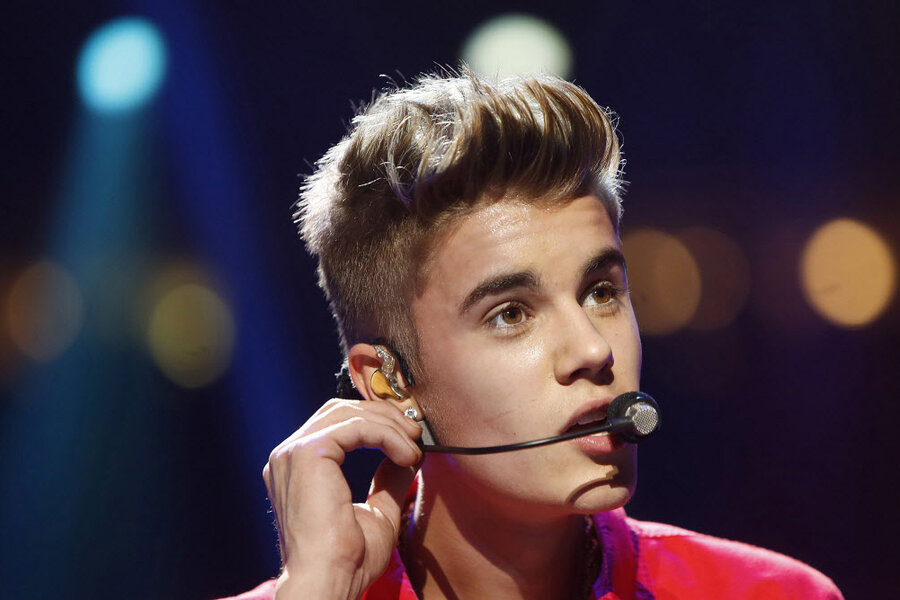Justin Bieber paparazzo killed: Lessons from this tragedy?
Loading...
On Tuesday evening in Los Angeles, a photographer crossing a California freeway on foot was struck by a vehicle and killed while chasing teen pop sensation Justin Bieber.
The incident harkens memories of Princess Diana's tragic death 15 years ago. While this time it was the paparazzo – not the celebrity – who paid the price, this tragedy raises again questions about privacy vs. First Amendment rights, stalking vs. publicity, and the perception of "the money shot."
The photographer, whose name has not been officially released, was chasing Bieber’s white Ferrari. According to CNN and gossip site Gawker, the photographer crossed Sepulveda Boulevard and began snapping pictures while the car was parked.
Police repeatedly told him to return to his car, and while re-crossing Sepulveda to leave, the photographer was struck by on-coming traffic. Bieber was not in the car at the time; a friend was reportedly driving it.
In 2010, the state of California passed the “Paparazzi Bill” in an effort to avoid such incidents. The law cracked down on photographers for reckless driving, blocking sidewalks, and creating a sense of “false imprisonment,” in pursuit of celebrity photographs.
The amendments included fining photographers up to $5,000 – or a year in jail – for breaking traffic laws or impeding the operation of a celebrity's vehicle.
Despite the law and others protecting against stalking, the reckless pursuit of Hollywood’s glitterati continued. In July, after a similar incident involving Bieber and a photographer in a high-speed chase, Los Angeles City Councilman Dennis Zine told CNN the paparazzi pursuit of Bieber was, “…a tragedy waiting to happen.”
Authorities tried to use the new California "paparazzi law" in this hot-pursuit case, but Judge Thomas Rubinson of Los Angeles County Superior Court ruled on Nov. 13, that the law was overly broad. He said, "The law is problematic because it covers news-gathering activities protected by the First Amendment."
He said lawmakers should simply have increased the penalties for reckless driving rather than targeting celebrity photographers. "Hypothetically," Rubinson said, "wedding photographers or even photographers rushing to a portrait shoot with a celebrity could face additional penalties if charged under the new law," according to The San Francisco Chronicle.
Since the death of Princess Diana, paparazzi and their subjects have struggled with questions of privacy and restrictions. How much privacy can a celebrity reasonably expect? Should tabloid photographers be given the same freedom-of-press protections as news photographers? Should entertainers, who often actively court publicity, be allowed to circumscribe when such attention is inappropriate?
According to CBS, the Royal Family attempted to tackle some of these questions by striking an unofficial deal with the paparazzi. Photographers would be given access to candid moments in return for a ban on long lenses in situations where members of the Royal Family could expect a reasonable amount of privacy.
The new policy produced some unforgettable photo ops, like Prince William and Kate Middleton’s wedding balcony kiss, but even a compromise between photographers and celebrities may only go so far. In today’s information age, where anyone with a smartphone is essentially both photographer and publisher, even the Royals can’t escape embarrassing photographs. For example, the nude photos taken of Prince Harry in Las Vegas this September were shot with a cell phone and apparently his knowledge.
Bieber, for one, is now calling for more legislation governing the interaction between photographers and their subjects. On Wednesday morning he released a statement expressing regret over the incident:
“While I was not present nor directly involved with this tragic accident, my thoughts and prayers are with the family of the victim. Hopefully this tragedy will finally inspire meaningful legislation and whatever other necessary steps to protect the lives and safety of celebrities, police officers, innocent public bystanders and the photographers themselves."
As long as the public craves photos of celebrities, and photographers can make money satisfying that craving, paparazzi will pursue the money shot. Legislation isn't likely to deter all reckless behavior. But perhaps in the wake of this tragedy, the paparazzi will pause, at least momentarily, before crossing the boundaries of decency and safety.







